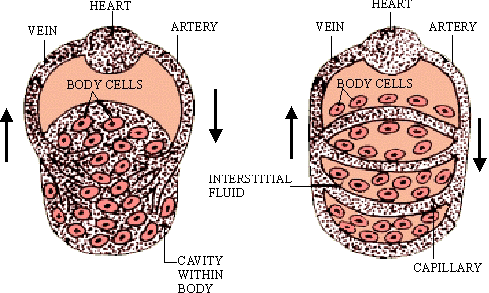|
PinkMonkey Online Study Guide-Biology
18.1 Vascular System

Click here to enlarge
Figure 18.2 Open Circulatory system Figure
18.3 Closed Circulatory System
There are two basic types of transport systems:
(1) In an open (vascular) circulatory
system (Fig 18.2) the blood is not completely enclosed within vessels
and it flows within blood vessels for only a limited part of its circuit.
The blood vessels open into the open fluid spaces (sinuses or hemocoel)
so that the circulating fluid (hemolymph) can reach the cells directly.
This type occurs in insects, crustaceans and molluscs. Circulation and
O2
transport is slower in an open circulatory system. (Smaller or sluggish
animals).
(2) In a closed circulatory system (Fig. 18.3)
the blood remains within a completely closed (unbroken) system of vessels,
and never comes in direct contact with the cells. This occurs in molluscs
(squids), annelids (earthworms), echinoderms, and vertebrates (animals
and humans). The advantages of a closed circulatory system are : faster
transport of oxygen; greater efficiency of blood flow; economy of blood
volume and maintenance of sufficient blood pressure for a large body.
A circulatory system, whether open or closed, has several
functions such as transportation of dissolved nutrients, hormones, gases,
antibodies, control of fluid volume, pH, and regulation of body temperature.
[next page]
|
Table of Contents
18.0 -
Introduction
18.1 -
Closed Vascular System
18.2 -
Heart
18.3 -
Arterial Blood Pressure
18.4 -
Blood
Chapter
19
|